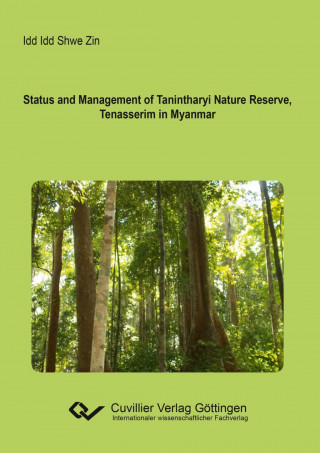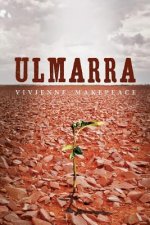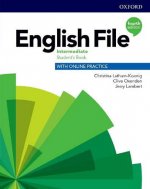
Code: 16242620
Status and Management of Tanintharyi Nature Reserve, Tenasserim in Myanmar
by Idd Idd ShweZin
In Myanmar, 16% of the total forest area is made up of rich evergreen forests which mostly occur in the northern and southern parts of the country. Tanintharyi Nature Reserve (TNR) is located in Southern Myanmar, an area under sev ... more
- Language:
 English
English - Binding: Paperback
- Number of pages: 292
Publisher: Cuvillier, 2017
- More about this

72.36 €
RRP: 80.14 €
You save 7.77 €

In stock at our supplier
Shipping in 6 - 8 days
You might also like
-

Wataha w podróży Himalaje na czterech łapach
4.13 € -56 % -

Tangible Soul
12.91 € -2 % -

Large Print Sudoku - Beginner: 80 Easy to Read, Large Print Sudoku Puzzles
9.28 € -1 % -

Ulmarra
27.24 € -2 % -

Seven Years Bad Luck Victory Over Cancer My Way
8.97 € -2 % -

All The Rage
12.91 € -2 % -

Death on Dartmoor
10.08 € -1 %
Give this book as a present today
- Order book and choose Gift Order.
- We will send you book gift voucher at once. You can give it out to anyone.
- Book will be send to donee, nothing more to care about.
More about Status and Management of Tanintharyi Nature Reserve, Tenasserim in Myanmar
You get 181 loyalty points
 Book synopsis
Book synopsis
In Myanmar, 16% of the total forest area is made up of rich evergreen forests which mostly occur in the northern and southern parts of the country. Tanintharyi Nature Reserve (TNR) is located in Southern Myanmar, an area under severe threat of rubber and palm oil plantations, ineffective land use shifting cultivation, encroachment into forests, and indiscriminate cutting leading to deforestation. Firstly, this study was carried out in TNR as an ecosystem analysis. In the core zone, 81 species in the primary moist evergreen forest-1 and 57 species in the degraded moist forest-1 were identified. In the buffer zone, 83 species in the primary moist evergreen forest-2; 86 species in the secondary moist evergreen forest-2, and 67 species in the degraded moist deciduous forest-2 were enlisted. For species-site matching and their performance, Michelia champaca, Aglaia andamanica, Ficus glomerata, Pterocarpus macrocarpus, Lithocarpus sp-1, and Cinnamonum pachphyllum in the highland areas and Vitex peduncularis, Oroxylum indicum, and Barringtonia cymosa in the degraded lowland areas were therefore the most adaptable species to environmental and salt stresses for reforestation in TNR. This study in the greenhouse found that the soil solute potentials of Xylia xylocarpa seedlings for the commercial potting soil and hydroponic gravel culture were -1.5 MPa and -1.2 MPa respectively for their tolerance to soil salinity to the reforestation programme in the TNR degraded land areas. The nitrogen content (% MS) of the important 35 tree species showed very weak relationship with their diameter distribution or slope b values in this study for light requirements. Moreover, top height could be used to classify species into groups for light requirements in this study. The minimum midday and saturated osmotic potentials could also be used to assess salt concentration in the root zone in order to select species for the reforestation program in the TNR degraded land areas.
 Book details
Book details
72.36 €
- Full title: Status and Management of Tanintharyi Nature Reserve, Tenasserim in Myanmar
- Author: Idd Idd ShweZin
- Language:
 English
English - Binding: Paperback
- Number of pages: 292
- EAN: 9783736995093
- ISBN: 3736995091
- ID: 16242620
- Publisher: Cuvillier
- Weight: 381 g
- Dimensions: 210 × 148 × 15 mm
- Date of publishing: 10. April 2017
Trending among others
-

The Book of Bill
23.71 € -14 % -

Gravity Falls Journal 3
16.44 € -23 % -

Berserk Deluxe Volume 1
44.30 € -12 % -

Pumpkin Spice Cafe
11.70 € -18 % -

Berserk Deluxe Volume 2
52.17 € -

White Nights
3.52 € -23 % -

It ends with us
8.67 € -19 % -

48 Laws Of Power
17.96 € -29 % -

Gilmore Girls: The Official Advent Calendar
28.86 € -18 % -

A Little Life
17.45 € -

Atomic Habits
15.94 € -14 % -

Berserk Deluxe Volume 3
48.84 € -3 % -

Jujutsu Kaisen, Vol. 23
11.09 € -15 % -

The 48 Laws of Power
24.52 € -5 % -

Surrounded by Idiots
10.49 € -29 % -

The Official Stardew Valley Cookbook
22.40 € -19 % -

Iron Flame
16.24 € -18 % -

Berserk Deluxe Volume 4
45.21 € -10 % -

A Good Girl's Guide to Murder
8.17 € -14 % -

A Curse For True Love
10.39 € -12 % -

Berserk Deluxe Volume 5
50.46 € -

It Starts with Us
10.69 € -17 % -

Powerless
10.49 € -23 % -

The Husky and His White Cat Shizun: Erha He Ta de Bai Mao Shizun (Novel) Vol. 6
16.14 € -19 % -

Twisted Love
9.78 € -24 % -

Court of Mist and Fury
9.38 € -18 % -

Twisted Hate
10.18 € -20 % -

Chainsaw Man, Vol. 16
11.29 € -13 % -

Psychology of Money
18.87 € -4 % -

Twisted Lies
9.78 € -24 % -

English File: Intermediate: Student's Book with Online Practice
25.63 € -7 % -

Reckless
10.29 € -20 % -

Berserk Deluxe Volume 6
51.17 € -

Gravity Falls: Lost Legends
17.75 € -15 % -

English File Upper Intermediate Student's Book with Student Resource Centre Pack (4th)
44.10 € -4 % -

Headway: Elementary: Student's Book with Online Practice
24.92 € -8 % -

Twisted Games
9.78 € -17 % -

Everything I Know About Love
10.39 € -29 % -

Court of Thorns and Roses Paperback Box Set (5 books)
50.05 € -20 % -

Court of Thorns and Roses
9.28 € -19 % -

Meow
20.78 € -

Vagabond (VIZBIG Edition), Vol. 1
24.52 € -

Headway: Elementary: Workbook Without Key
13.92 € -

Once Upon A Broken Heart
9.88 € -23 % -

The Ballad of Never After
10.08 € -21 % -

SOLO LEVELING V09
17.75 € -15 % -

A Court of Wings and Ruin
10.79 € -6 % -

The Courage To Be Disliked
10.99 € -27 % -

A Court of Silver Flames
10.08 € -15 %
Collection points Bratislava a 2642 dalších
Copyright ©2008-24 najlacnejsie-knihy.sk All rights reservedPrivacyCookies


 15549 collection points
15549 collection points Delivery 2.99 €
Delivery 2.99 € 02/210 210 99 (8-15.30h)
02/210 210 99 (8-15.30h)